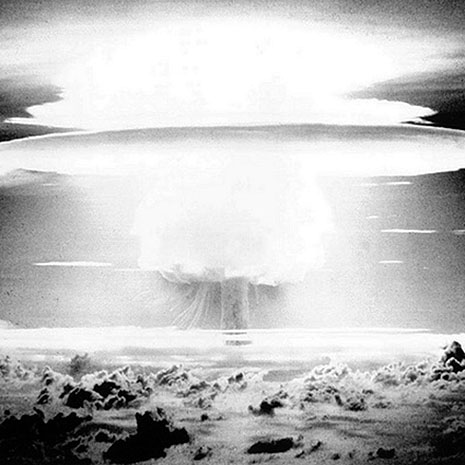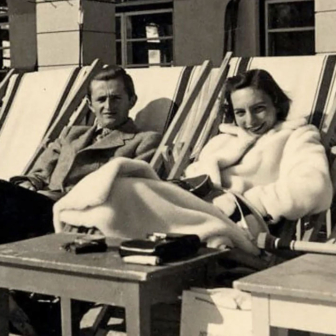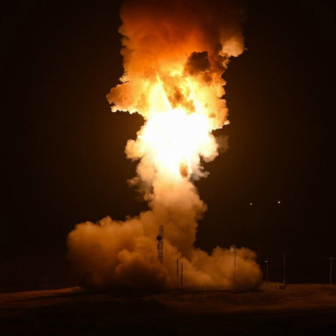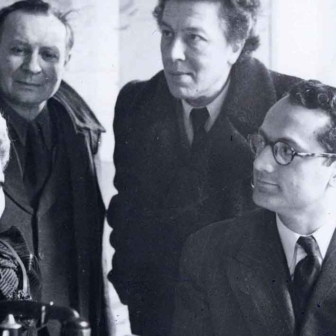SIXTY years ago, on 1 March 1954, Rinok Riklon was a young girl living on Rongelap, one of the northern atolls of the Marshall Islands. Then the Bomb went off.
“People were playing with the fallout as it fell from the sky,” she told me through an interpreter. “We put it in our hair as if it was soap or shampoo. But later I lost all of my hair.”
The American government had exploded a thermonuclear device on Bikini Atoll, 120 kilometres to the west. Codenamed Bravo and weighing in at fifteen megatons, this was the largest nuclear device the military had tested. It sent a cloud of radioactive fallout across the northern atolls of the Marshall Islands, which were part of the United Nations Trust Territory of the Pacific Islands, a strategic UN trusteeship administered by the United States.
The Republic of the Marshall Islands is now an independent country, but the people of this Micronesian nation still live with the health and environmental consequences of the nuclear weapons program. Bravo was just one of sixty-seven atmospheric nuclear tests on Bikini and Enewetak atolls between 1946 and 1958.
On the eve of the test, the American military had received weather reports indicating that atmospheric conditions “were getting less favourable” and winds at 20,000 feet “were headed for Rongelap to the east.” In spite of these warnings, the test went ahead. Islanders on Rongelap, Ailinginae and Utrik atolls were only evacuated for emergency medical care a few days later. The evacuation began a decades-long odyssey that has left many people still living in exile from their contaminated atolls.
Lemyo Abon was just fourteen years old when Bravo spread fallout across parts of Rongelap atoll. After living on the contaminated atoll for thirty years, she was evacuated to Mejatto Island in 1985 aboard the Rainbow Warrior. (Just weeks later, this Greenpeace vessel was sunk in Auckland Harbour by French intelligence agents who had been sent halfway around the world to sabotage protests over French nuclear testing at Moruroa and Fangataufa atolls.) In 2007, she moved to the Marshall Islands capital, Majuro – still far away from her home island.
“We are still living in this place in exile from our homeland, like a coconut floating in the sea,” she told me through an interpreter. “The United States has to live up to their responsibility and make sure our children and grandchildren will be cared for.”
Returning home is difficult. Food plants like breadfruit and coconut take up radioactive Cesium-137 from the soil, and this hazard has persisted on Rongelap and other contaminated islands to this day. Although the US Congress has allocated $45 million for a trust fund to finance the partial clean-up of the main island, less than 10 per cent of Rongelap, Rongerik and Ailinginae atolls have been remediated and exiled residents are calling for more comprehensive efforts before they return home.
AFTER four decades as a US-administered strategic trust territory after the second world war, the Marshall Islands and neighbouring Micronesian states moved to self-government in the mid 1980s. The governments of the Marshall Islands and the United States adopted a Compact of Free Association – a program of American aid in return for defence cooperation – in 1986.
As part of the negotiations, both governments agreed to establish a Nuclear Claims Tribunal to receive and adjudicate claims for personal injury and property damage resulting from the nuclear tests. In exchange for the cessation of hundreds of millions of dollars’ worth of civil claims lodged in US courts, a US$150 million trust fund was established to fund payouts determined by the tribunal’s judges. The Marshall Islands had to give up all claims “past, present and future” that were “based upon, arise out of or are in any way related to the Nuclear Testing Program, and which are against the United States.”
The Nuclear Claims Tribunal can award costs for restitution and clean-up of contaminated lands, and has allocated property damage awards, including compensation for loss of land use and for hardship and suffering. But the trust fund is nearly exhausted and cannot meet the court’s rulings and damages awards. As a result, more than US$2.3 billion of compensation remains unpaid.
In 2000, the Republic of the Marshall Islands lodged a Changed Circumstances Petition with the US Congress, seeking extra funding for the tribunal. But the United States refused to pay the remaining compensation for damage caused by the nuclear tests at Bikini and Enewetak atolls. Fourteen years on, the Obama administration has followed previous US governments in arguing that all avenues to respond to the Changed Circumstances Petition have been exhausted.
For people who staffed the Nuclear Claims Tribunal after 1988, Washington’s refusal to meet its responsibilities still grates. Bill Graham, who served as the Public Advocate at the tribunal for twenty-one years and now works as an adviser to the Marshall Islands foreign ministry, says there are still billions of dollars owed to affected communities from Bikini, Enewetak, Utrik and Rongelap after rulings by the Tribunal.
“For the property damage awards, if you add up the clean-up and restoration, the loss and damage, and the hardship and suffering, you wind up with just under US$2.3 billion remaining owed on those awards,” he says. “The tribunal did make two very small payments, one in 2002 and one in 2003, to the people of Bikini and Enewetak. But this is totalling less than $4 million of that $2.3 billion.”
Graham said that there were smaller but still significant amounts owing for health impacts. “The tribunal awarded personal injury compensation to nearly 2000 people of nearly US$96 million. But again, due to insufficient funding in the settlement agreement, we were only able to spend $73 million of that $96 million. So more than $23 million is still owed to those people.”
The tribunal also awarded US$531 million for clean-up of residual contamination in those atolls, beyond existing amounts allocated by the US government. It made its last compensation award and some partial payments in late 2008. Since then it has suspended awards and payment for lack of funds, with evidence being preserved by two part-time clerical staff. More than six years after the tribunal issued its ruling on property claims for Rongelap, there is no funding to pay out the compensation.
The US government’s obstinate refusal to address the issue has sparked increasing scrutiny. Marshall Islanders have welcomed a 2012 report to the UN Human Rights Council by UN special rapporteur Calin Georgescu, who visited the Marshall Islands and the United States in early 2012. “The nuclear testing resulted in both immediate and continuing effects on the human rights of the Marshallese,” he wrote. “According to information received by the special rapporteur, radiation from the testing resulted in fatalities and in acute and long-term health complications… exacerbated by near-irreversible environmental contamination, leading to the loss of livelihoods and lands. Moreover, many people continue to experience indefinite displacement.”
PEOPLE are gathering from Majuro to Arkansas to commemorate the sixtieth anniversary of the Bravo test this week. Around the region, the anniversary of the test is commemorated as Nuclear Free and Independent Pacific Day on 1 March each year. The day highlights longstanding and ongoing opposition to nuclear weapons in a region that experienced 315 American, British and French nuclear tests between 1946 and 1996.
Beginning in the 1950s, churches, trade unions, women’s organisations and customary leaders in the islands campaigned for an end to nuclear testing and the abolition of nuclear weapons. On 6 May 1954, Marshall Islanders lodged a petition with the United Nations Trusteeship Council requesting that “all experiments with lethal weapons in this area be immediately ceased.” The petition stated that people were “not only fearful of the danger to their persons from these deadly weapons” but “also concerned for the increasing number of people removed from their land.”
These concerns were echoed by islanders facing British and French nuclear testing. Even before gaining independence from New Zealand, the Cook Islands and Samoa protested against Britain’s testing program at Christmas Island and Malden Island in 1957–58. “Nations engaged in testing these bombs in the Pacific should realise the value of the lives of the people settled in this part of the world,” commented the Indo-Fijian newspaper Jagriti in 1957. “They too are human beings, not ‘guinea pigs.’”
In 1975, the Pacific Conference of Churches joined with the Student Christian Movement, the Fiji YWCA and the antinuclear group Against Testing on Moruroa to host the first Nuclear Free Pacific conference in Suva, Fiji. The conference spawned the Nuclear Free and Independent Pacific movement, linking the cause of disarmament to the right to self-determination. As the New Hebrides delegation told the meeting in Suva: “The main objective of this conference is to end nuclear tests in the Pacific, but the more we discuss it, [the more] it becomes obvious that the main cause is colonialism.”
As they have gained independence from colonial powers, Pacific governments have expressed their support for nuclear disarmament. At the height of the US–Soviet arms race, on Hiroshima Day 1985, members of the Pacific Islands Forum signed and ratified the South Pacific Nuclear Free Zone Treaty. This important contribution to global disarmament inspired similar initiatives in Southeast Asia, Africa and Central Asia, and all land areas in the southern hemisphere – except Timor-Leste – are now covered by these zones, which ban the development and deployment of nuclear weapons by treaty signatories. Individual states, from Vanuatu and New Zealand to South Africa, Austria and Mongolia, have declared their territory nuclear-free.
After massive protests during the 1980s, the nuclear disarmament movement was largely demobilised, with peace activists campaigning instead on landmines, cluster bombs, the Arms Trade Treaty, and wars in Iraq, Afghanistan and other developing nations. But with the passage of treaties to ban or constrain the use of landmines, cluster bombs, chemical weapons and small arms, there is new momentum to ban the most dangerous weapons of mass destruction.
With the official Conference on Disarmament stymied by the veto of nuclear powers and unable to agree on any action, non-nuclear nations are not standing idle. A number of new initiatives aim to sidestep the nuclear weapons states and advance efforts for nuclear abolition.
Launched in 2007, the International Campaign to Abolish Nuclear Weapons has expanded to sixty countries and is campaigning for a global treaty to ban nuclear weapons. Its cause has been aided by the 2011 decision of the Red Cross and Red Crescent movement to throw its worldwide network of affiliates into campaigning on the humanitarian impacts of nuclear weapons.
In February this year, 146 governments – but none of the nuclear powers – gathered in Nayarit, Mexico, for the Second Conference on the Humanitarian Impact of Nuclear Weapons. Following a ground-breaking meeting in Oslo in March 2013, this gathering brought together non-nuclear governments to pledge action towards nuclear disarmament and an treaty. The government of Austria has agreed to host a third conference, continuing the momentum. These conferences discuss the impact of nuclear weapons on global public health and the environment, economic growth and sustainable development, but also the risk that nuclear weapons, if not banned and eliminated, will one day be used again.
Maintaining its support of the US policy of “extended nuclear deterrence,” Australia stands aside from these efforts. Responding to discussion of a nuclear ban treaty in Mexico, foreign minister Julie Bishop said, “Their argument ‘to ban the bomb’ may be emotionally appealing, but the reality is that disarmament cannot be imposed this way. Just pushing for a ban would divert attention from the sustained, practical steps needed for effective disarmament.”
Even after the end of nuclear testing in the Pacific region in 1996, many island governments have continued to support efforts for nuclear disarmament. In the UN General Assembly and summits, Pacific nations have voted in favour of resolutions calling for a treaty banning nuclear weapons.
On 1 March, the voices of Rinok Riklon, Lemyo Abon and thousands of nuclear survivors around the Pacific islands will be a reminder that many people have been adversely affected by the development and deployment of nuclear weapons. Sixty years after the Bravo test, it’s time for action to abolish these weapons. •




